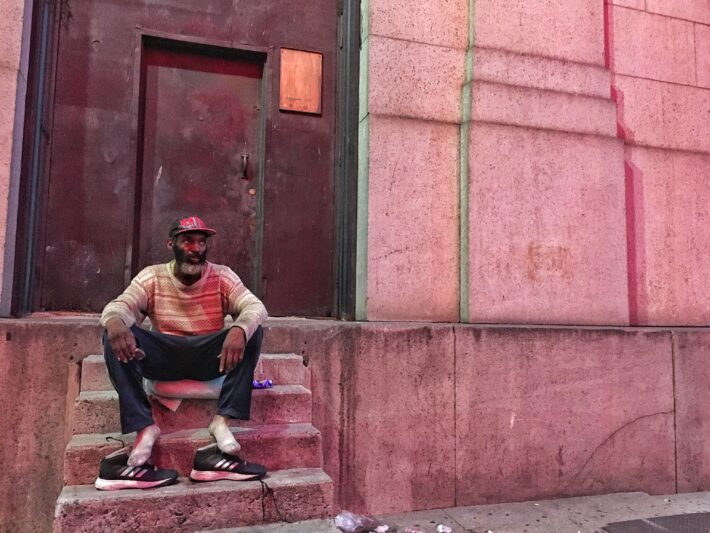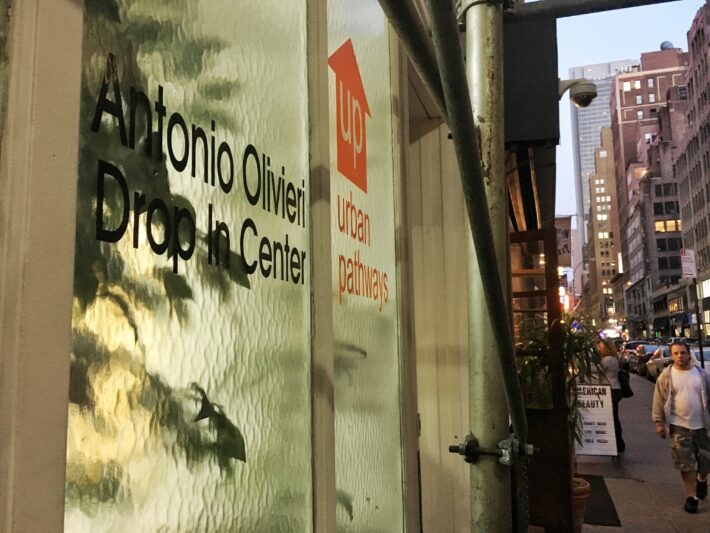Homelessness is surging in New York City, and efforts to address the crisis have become strained, even as temporary housing will likely see increases as winter approaches.
For many homeless New Yorkers, city-sponsored programs and services provide adequate relief from the strife of daily life in one of the country’s most cost-prohibitive metropolitan areas. But as city officials race to keep pace with a growing population, other individuals slip through the cracks, become ensnared in a complex web of eligibility requirements, or become tripped up by little more than fate.
In Midtown, known for its dense population of homeless people in and around the neighborhood’s transportation and touristic hubs and along its commercial corridors, some feel shorted by the system.
“Someone gets help, and they’re in the same exact position as someone else, but this one gets help and the other one does not,” said Justin Johnson, between puffs of a cigarette outside of the Olivieri Drop-In Center for Homeless Adults on West 30th Street, where he’s been staying for the past month. “There’s a lot of politics.”

Homelessness in the city is at an all-time high, with some 60,000 — and likely more — men, women and children sleeping in shelters for the month of September alone, according to figures released on September 29 by the Department of Homeless Services. Officials said the figure was 7,000 less than what had been projected, an improvement linked to the success of programs created under Mayor Bill de Blasio, whose administration has prioritized combating the crisis.
“Our current programs have substantially slowed the rate of growth in homelessness,” said Steven Banks, who chairs the Department of Social Services, and oversees the DHS. “The city is opening new shelters across the city to ensure that families and individuals can maintain the community connections that will help them leave shelters as soon as possible,” he said.
Among the services added to a bevy of assistance programs are increased legal aid and emergency rent for tenants who might be a paycheck or two away from losing their lease. But other initiatives, such as the rental assistance program Living in Communities, known as LINC, which provides vouchers to eligible New Yorkers, still face roadblocks.
“That’s my problem right now; I have a voucher but the landlords don’t want theses vouchers,” said Alex G., who is homeless and did not want to be identified by his last name.
Landlords cannot refuse an applicant based on whether they present a voucher, according to city administrative code. But for people like Alex, who have bounced around shelters and drop-in centers, the competitive nature of New York’s housing market means that he loses out to people with more money. Alex said the city approaches real estate companies to find out which landlords accept LINC or Section 8 vouchers, “but in the end the people that get the apartments are the people that come with cash,” he said.
Finding permanent housing for New York’s homeless is one of the biggest challenges the city faces, according to Lauren Taylor, deputy director of the Manhattan outreach consortium at Goddard Riverside, the lead outreach provider for the borough. Providers like Goddard Riverside contract with the city to operate everything from shelters to street outreach teams.
“At this point, our teams are out there 24/7 responding to the community and our clients’ needs. I think the big need is for more housing,” she said.
The de Blasio administration has sought to increase the number of shelters, and expand night-bed programs at places like churches, in areas like Midtown West that have a high concentration of homeless people. But some of those efforts have been delayed by community members concerned about the neighborhood impact of high-volume shelters.

At a September Community Board 5 meeting over a proposed emergency shelter on West 24th Street, angry residents complained about the area’s existing concentration of homeless services, pointing to the 300-bed Jack Ryan residence on West 25th street, operated by the Bowery Residence Committee. That facility, says Jesse Bodine, the district manager of Community Board 4, created problems in the surrounding area, where residents felt wary about the number of homeless people congregating around the shelter.
Bodine said if the city continues to place large shelters in residential areas where the homeless can’t “go outside and enjoy themselves,” then there would be “an inevitable impact on the block.”
Community Board 4 executives have advocated for boosting the number of peace officers — on-site security personnel — at the Jack Ryan residence, which fits into a recent city-led effort to increase security and mental health staff at shelters. The DHS would not elaborate on how the plans, announced last January, were rolled out, but at one men’s shelter on West 30th street, half a dozen peace officers from at least three different agencies — NYPD, DHS, and a private contractor — were positioned near the entrance, where homeless men come and go.
Even with added security measures, many Midtown shelters maintain a reputation built upon years of violence, disrepair and subpar services. Andrew, who has lived in shelters for two years and would not give his last name, stood outside Olivieri and complained that two nearby facilities, including the Jack Ryan residence and another on East 31st were “horror stories” in terms of safety, services, and overall quality.
But advocates say there’s rarely a simple fix, such as adding more staff. Catharine Trapani, executive director of Homeless Services United said that some non-profits operated with budgets set in decades-old contracts with the city.
“When the shelter system started to get built up and non-profits entered contracts with the city, 20-30 years later those rates haven’t changed but costs have gone up, affecting staffing ratios, repairs, and low pay for employees,” said Trapani. “It’s really just been a question of rightsizing the budgets to catch up.”
For the most part, it seems, city officials agree.
“We said five months ago when we announced the results of the 90-day review of homeless services that it would take time to reverse 20 years of policies and that the number of people in shelter might continue to grow,” said Banks.
According to outreach personnel, the bottom line is providing help to those who need it, regardless of constraints.
“Anybody that we see, we’re going to try to help them get to some sort of option indoors,” said Taylor. “We always want to encourage them to come to a warmer and safer place.”